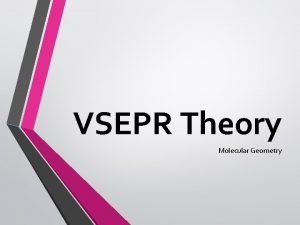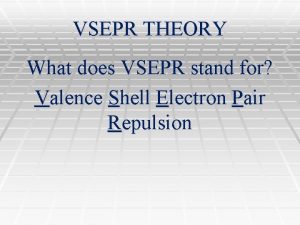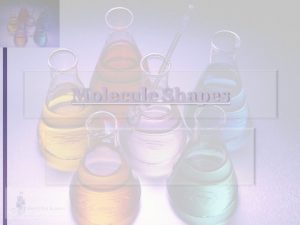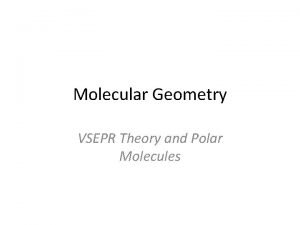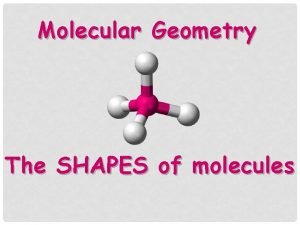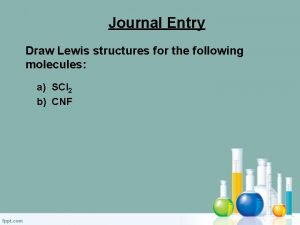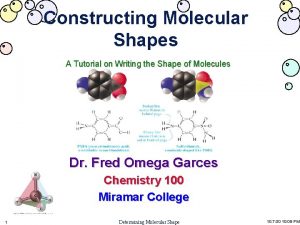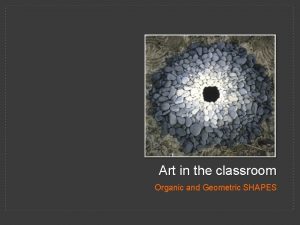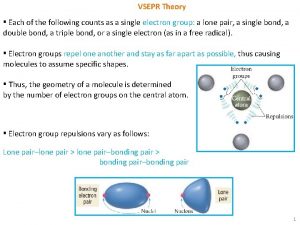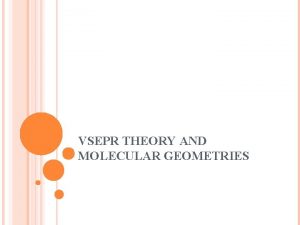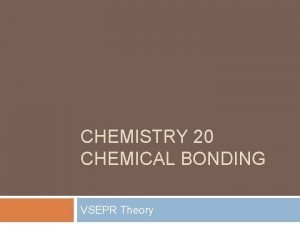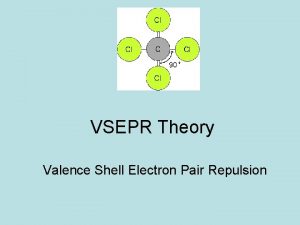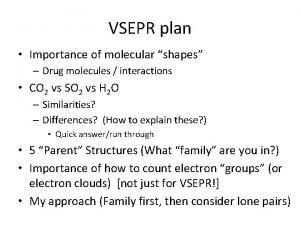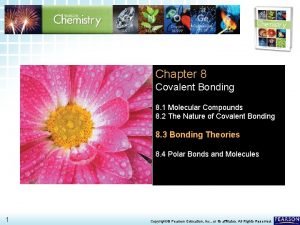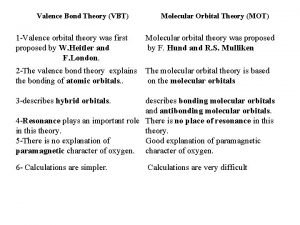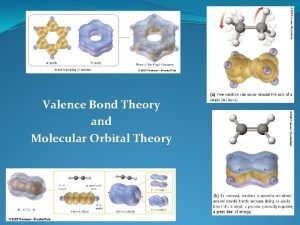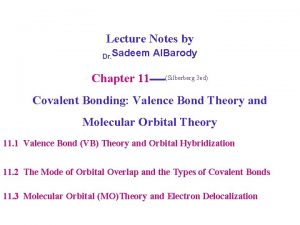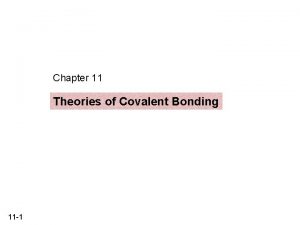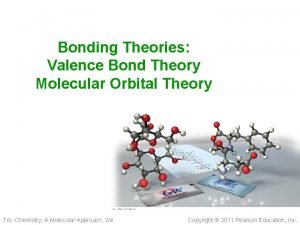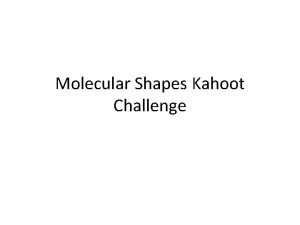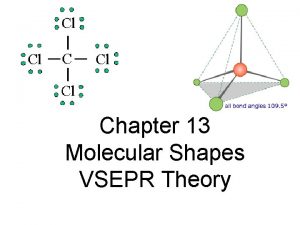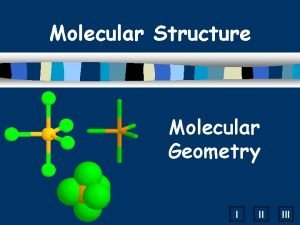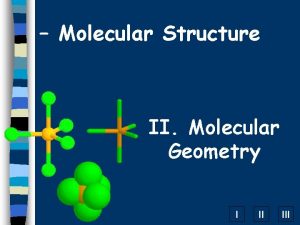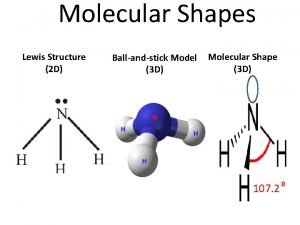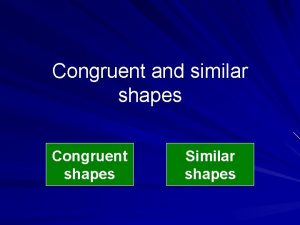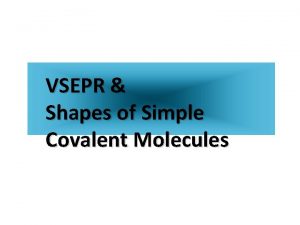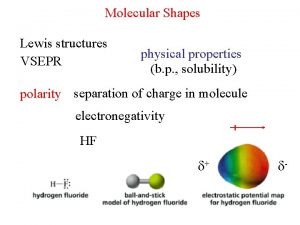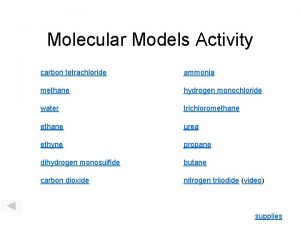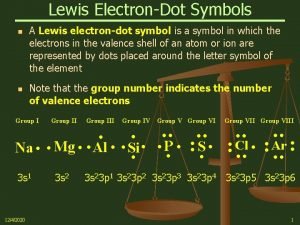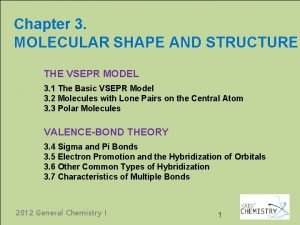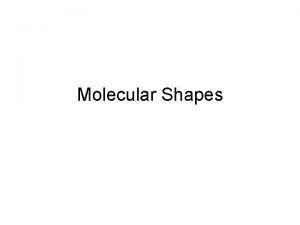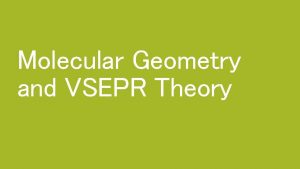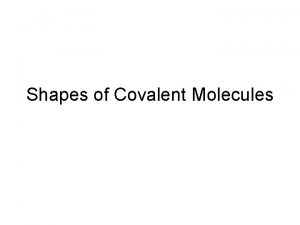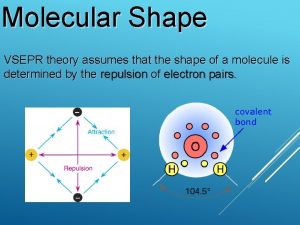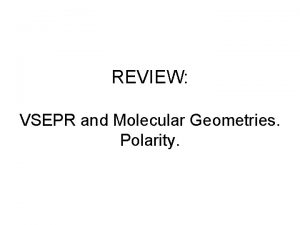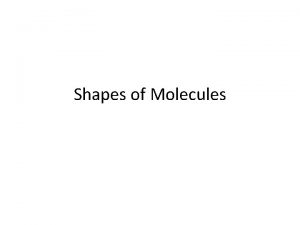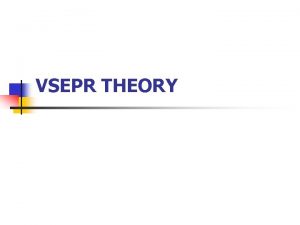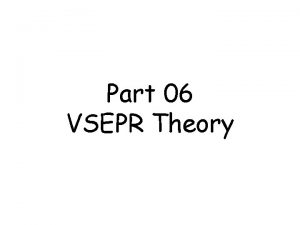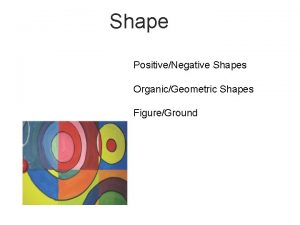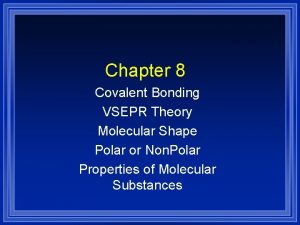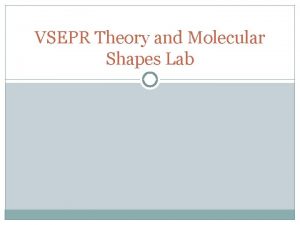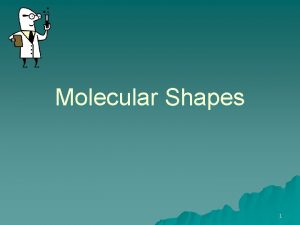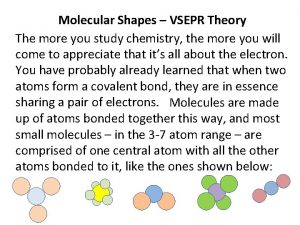Chapter 13 Molecular Shapes VSEPR Theory Molecular Shape










































- Slides: 42

Chapter 13 Molecular Shapes VSEPR Theory

Molecular Shape • Molecular shape or molecular geometry is the three-dimensional arrangement of the atoms in a molecule.

Molecular Shape • Molecular shape determines several properties of a substance including: – reactivity – polarity – phase of matter – color – magnetism – biological activity

Olfaction – sense of smell • Lock-and-Key Theory: humans can smell various odors because each threedimensional odor molecule fits into only one type of receptor.


Gustation – the sense of taste • Taste receptors are located on the tongue and are sensitive to four major tastes: salty, sweet, sour and bitter. • Taste receptors respond differentially to the varying shapes of the food molecules that we eat.

H 2 H 2(1) = 2 e- H Any 2 atoms linear

What about molecules consisting of more than two atoms For this we must use the VSEPR Theory

VSEPR Theory • Valence Shell Electron Pair Repulsion Theory • Predicts the molecular shape of a bonded molecule containing a central atom(s). • Electrons around the central atom arrange themselves as far apart from each other as possible • So only electrons (lone pairs or bonds) connected to the central atom are important.

Five Molecular Shapes See the table in your notes


Steps in Determining Molecular Shape 1. Draw the Lewis Structure for the Molecule. 2. Count the number of atoms attached to the central atom. 3. Count the number of lone pairs attached to the central atom. 4. Use your counts on steps 2 and 3 to determine the shape of the molecule.


H 2 S 2(1)+6 = 8 e- • Dihydrogen monosulfide is commonly known as sewer gas. This colorless, toxic and flammable gas is responsible for the foul odor of rotten eggs. H • • S • • H 2/2 angular

H 2 S • Dihydrogen monosulfide is commonly known as sewer gas. This colorless, toxic and flammable gas is responsible for the foul odor of rotten eggs. • • H S H

Methane (CH 4) 4 + 4(1) = 8 e-

Methane (CH 4) 4 + 4(1) = 8 e- 4 atoms attached to the central atom. 0 lone pairs on the central atom. 4/0 Tetrahedral shape

Methane (CH 4) 4 + 4(1) = 8 e- 4 atoms attached to the central atom. 0 lone pairs on the central atom. 4/0 Tetrahedral shape






HCN H C 2/0 linear 1+4+5 = 10 e- • • N

H 2 S • • S H H 2/2 angular





CH 4 4/0 tetrahedral





SOCl 2

SOCl 2 .

SOCl 2 .

SOCl 2

SOCl 2

Draw the Lewis structure for an acetate ion? You learned acetate as C 2 H 3 O 2 -. However writing it as CH 3 CO 2 - will give you a better understanding of its Lewis structure.

Draw the Lewis structure for an acetate ion?

What’s the shape of acetate? 4/0 3/0 tetrahedral trigonal planer
 How to memorize molecular geometry
How to memorize molecular geometry Different molecular structures
Different molecular structures What does vsepr
What does vsepr Lewis structure shape chart
Lewis structure shape chart Vsepr theory angles
Vsepr theory angles Onh nonbonding electrons
Onh nonbonding electrons Bonding theories
Bonding theories Nocl bond angle
Nocl bond angle Hno vsepr shape
Hno vsepr shape These are shapes that seem to follow no rules.
These are shapes that seem to follow no rules. How to calculate bond angle
How to calculate bond angle Vsepr theory explain
Vsepr theory explain Vsepr theory formula
Vsepr theory formula Vsepr theory project
Vsepr theory project Vsepr theory assignment
Vsepr theory assignment Vsepr theory
Vsepr theory Ab2e2 molecular geometry
Ab2e2 molecular geometry Importance of molecular geometry
Importance of molecular geometry Bond 8 generacji
Bond 8 generacji Mot and vbt difference
Mot and vbt difference Molecular orbital theory vs valence bond theory
Molecular orbital theory vs valence bond theory Valence bond theory and molecular orbital theory
Valence bond theory and molecular orbital theory 11:55
11:55 Atomic orbitals of oxygen
Atomic orbitals of oxygen Kahoot shapes
Kahoot shapes Shapes and polarity of molecules
Shapes and polarity of molecules Bfcl2 molecular shape
Bfcl2 molecular shape Ncl2+ shape
Ncl2+ shape Common molecular shapes
Common molecular shapes Common molecular shapes
Common molecular shapes Molecular structure
Molecular structure Molecular shapes
Molecular shapes Color by number molecular geometry and polarity
Color by number molecular geometry and polarity Differentiate similar polygons from congruent polygons
Differentiate similar polygons from congruent polygons Which of these shapes is congruent to the given shape?
Which of these shapes is congruent to the given shape? What is a covalent bond simple definition
What is a covalent bond simple definition Giant molecular structure vs simple molecular structure
Giant molecular structure vs simple molecular structure Zinc oxide + nitric acid → zinc nitrate + water
Zinc oxide + nitric acid → zinc nitrate + water Ax3e molecular shape
Ax3e molecular shape Ch2o molecular geometry
Ch2o molecular geometry Hydrogen monochloride
Hydrogen monochloride Vsepr notation
Vsepr notation I31- lewis structure
I31- lewis structure
